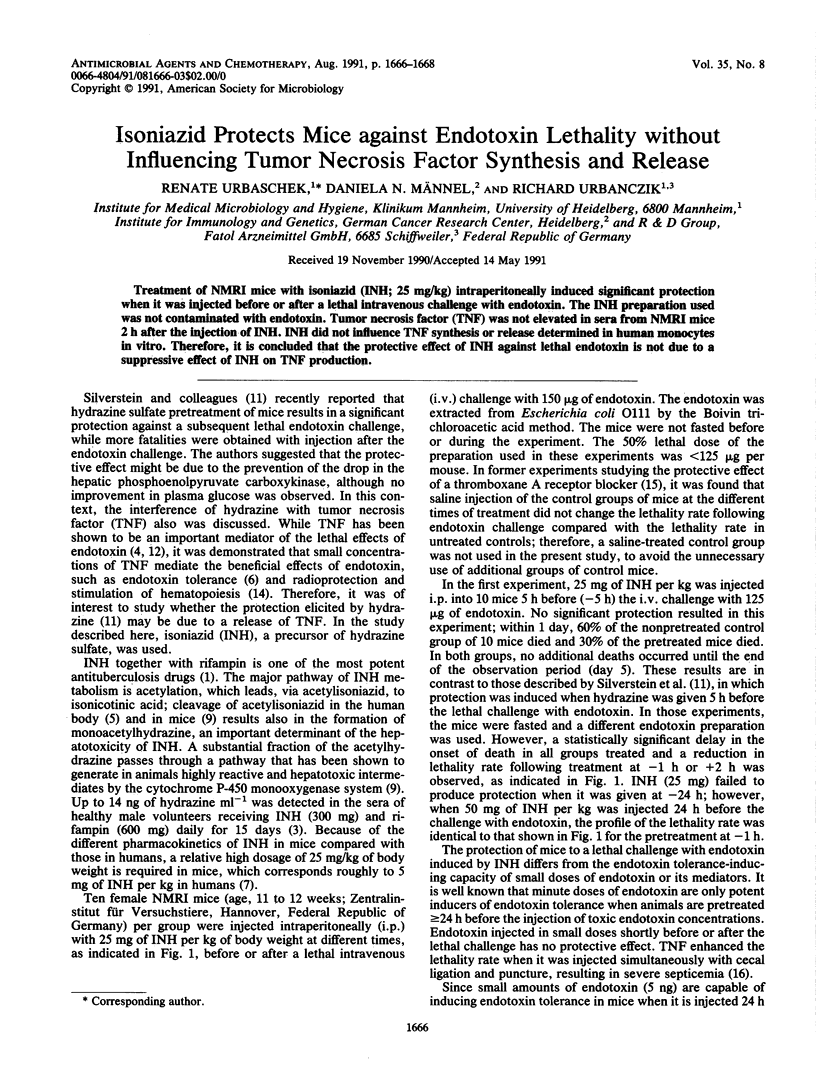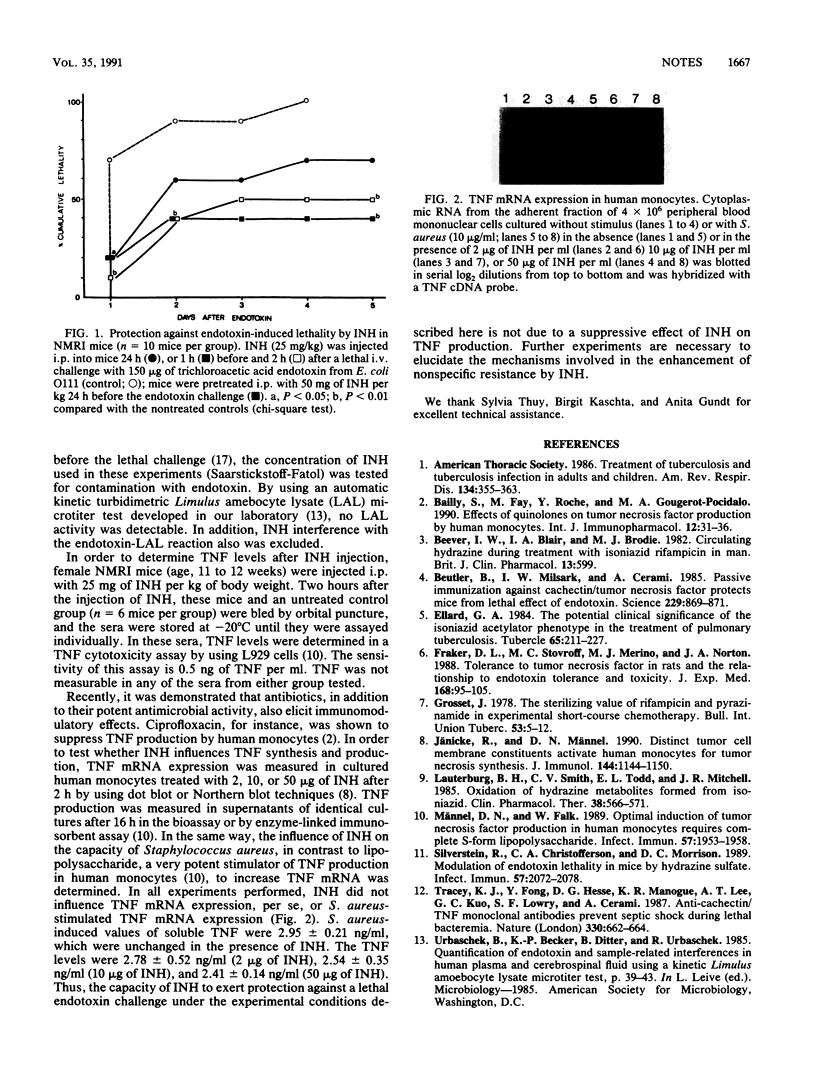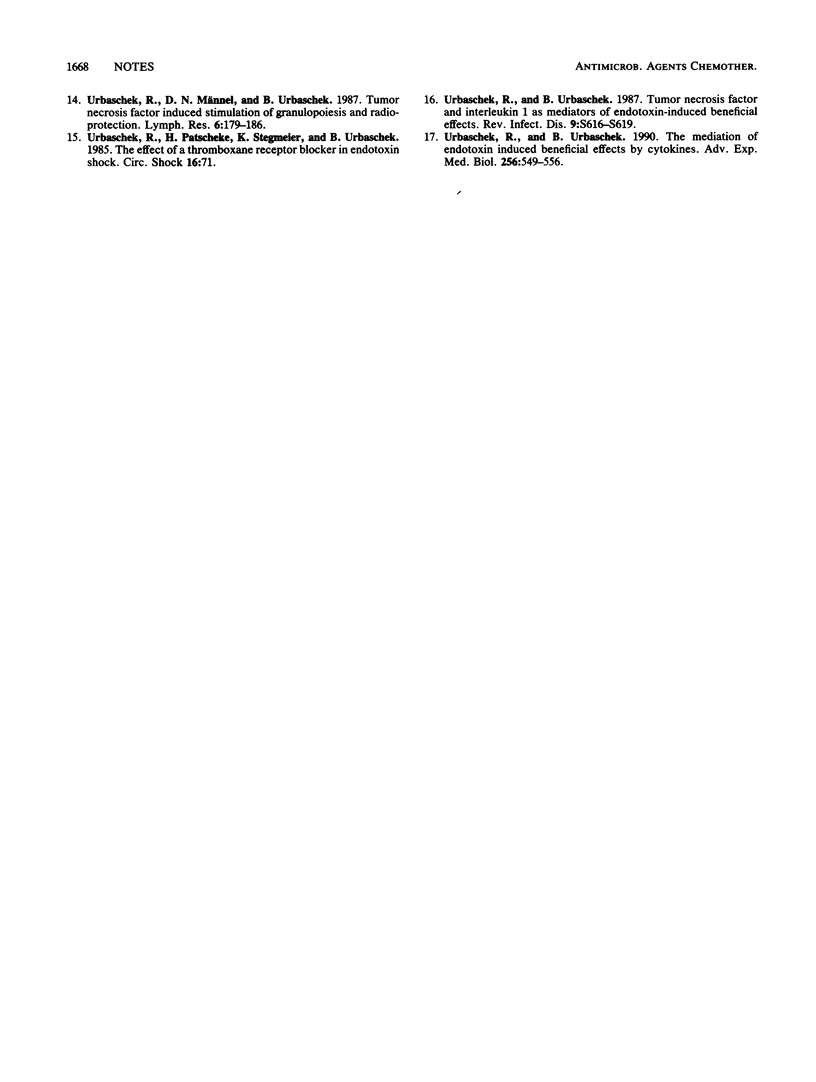Abstract
Treatment of NMRI mice with isoniazid (INH; 25 mg/kg) intraperitoneally induced significant protection when it was injected before or after a lethal intravenous challenge with endotoxin. The INH preparation used was not contaminated with endotoxin. Tumor necrosis factor (TNF) was not elevated in sera from NMRI mice 2 h after the injection of INH. INH did not influence TNF synthesis or release determined in human monocytes in vitro. Therefore, it is concluded that the protective effect of INH against lethal endotoxin is not due to a suppressive effect of INH on TNF production.
Full text
PDF


Images in this article
Selected References
These references are in PubMed. This may not be the complete list of references from this article.
- Bailly S., Fay M., Roche Y., Gougerot-Pocidalo M. A. Effects of quinolones on tumor necrosis factor production by human monocytes. Int J Immunopharmacol. 1990;12(1):31–36. doi: 10.1016/0192-0561(90)90065-u. [DOI] [PubMed] [Google Scholar]
- Beutler B., Milsark I. W., Cerami A. C. Passive immunization against cachectin/tumor necrosis factor protects mice from lethal effect of endotoxin. Science. 1985 Aug 30;229(4716):869–871. doi: 10.1126/science.3895437. [DOI] [PubMed] [Google Scholar]
- Ellard G. A. The potential clinical significance of the isoniazid acetylator phenotype in the treatment of pulmonary tuberculosis. Tubercle. 1984 Sep;65(3):211–227. doi: 10.1016/0041-3879(84)90079-5. [DOI] [PubMed] [Google Scholar]
- Fraker D. L., Stovroff M. C., Merino M. J., Norton J. A. Tolerance to tumor necrosis factor in rats and the relationship to endotoxin tolerance and toxicity. J Exp Med. 1988 Jul 1;168(1):95–105. doi: 10.1084/jem.168.1.95. [DOI] [PMC free article] [PubMed] [Google Scholar]
- Grosset J. The sterilizing value of rifampicin and pyrazinamide in experimental short-course chemotherapy. Bull Int Union Tuberc. 1978 Mar;53(1):5–12. [PubMed] [Google Scholar]
- Jänicke R., Männel D. N. Distinct tumor cell membrane constituents activate human monocytes for tumor necrosis factor synthesis. J Immunol. 1990 Feb 1;144(3):1144–1150. [PubMed] [Google Scholar]
- Lauterburg B. H., Smith C. V., Todd E. L., Mitchell J. R. Oxidation of hydrazine metabolites formed from isoniazid. Clin Pharmacol Ther. 1985 Nov;38(5):566–571. doi: 10.1038/clpt.1985.225. [DOI] [PubMed] [Google Scholar]
- McCuskey R. S., McCuskey P. A., Urbaschek R., Urbaschek B. Kupffer cell function in host defense. Rev Infect Dis. 1987 Sep-Oct;9 (Suppl 5):S616–S619. [PubMed] [Google Scholar]
- Männel D. N., Falk W. Optimal induction of tumor necrosis factor production in human monocytes requires complete S-form lipopolysaccharide. Infect Immun. 1989 Jul;57(7):1953–1958. doi: 10.1128/iai.57.7.1953-1958.1989. [DOI] [PMC free article] [PubMed] [Google Scholar]
- Silverstein R., Christoffersen C. A., Morrison D. C. Modulation of endotoxin lethality in mice by hydrazine sulfate. Infect Immun. 1989 Jul;57(7):2072–2078. doi: 10.1128/iai.57.7.2072-2078.1989. [DOI] [PMC free article] [PubMed] [Google Scholar]
- Tracey K. J., Fong Y., Hesse D. G., Manogue K. R., Lee A. T., Kuo G. C., Lowry S. F., Cerami A. Anti-cachectin/TNF monoclonal antibodies prevent septic shock during lethal bacteraemia. Nature. 1987 Dec 17;330(6149):662–664. doi: 10.1038/330662a0. [DOI] [PubMed] [Google Scholar]
- Urbaschek R., Männel D. N., Urbaschek B. Tumor necrosis factor induced stimulation of granulopoiesis and radioprotection. Lymphokine Res. 1987 Summer;6(3):179–186. [PubMed] [Google Scholar]
- Urbaschek R., Urbaschek B. The mediation of endotoxin-induced beneficial effects by cytokines. Adv Exp Med Biol. 1990;256:549–556. doi: 10.1007/978-1-4757-5140-6_48. [DOI] [PubMed] [Google Scholar]



